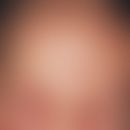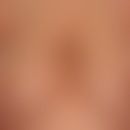Synonym(s)
DefinitionThis section has been translated automatically.
Occurrence/EpidemiologyThis section has been translated automatically.
You might also be interested in
EtiopathogenesisThis section has been translated automatically.
Stimulation of the sebaceous gland follicles by maternal androgens. Due to persistent androgenic stimuli, sebaceous gland hyperplasia is more frequent and longer lasting in breastfed children. It usually subsides after 4-6 months.
LocalizationThis section has been translated automatically.
ClinicThis section has been translated automatically.
Isolated standing or disseminated sowing of densely aggregated, 0.2-0.5 cm large, skin-coloured or yellowish-reddish, centrally slightly dented papules. Mostly accompanied by seborrhoea (Seborrhoea oleosa).
Differential diagnosisThis section has been translated automatically.
Milia: no centrofacial accentuation; roundish with firm consistency
Acne infantum: centrofacial stress; inflammatory; pustular
Pityrosporum folliculitis of the infant: acute follicular pustules, face, neck, capillitium
TherapyThis section has been translated automatically.
LiteratureThis section has been translated automatically.
- Kaufmann R (1987) Diffuse (presenile) sebaceous gland hyperplasia, a new entity? dermatologist 38: 31-35
- Zouboulis C et al (2003) Ciclosporin A - induced sebaceous glands hyperplasia. Br J Dermatol 149: 198-200
Incoming links (1)
Milia of the infant;Disclaimer
Please ask your physician for a reliable diagnosis. This website is only meant as a reference.




